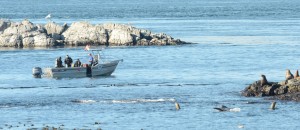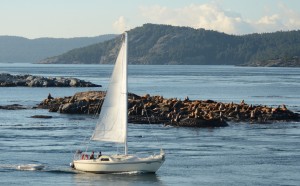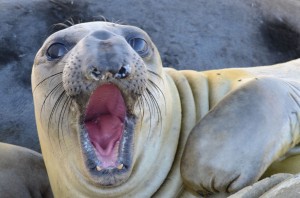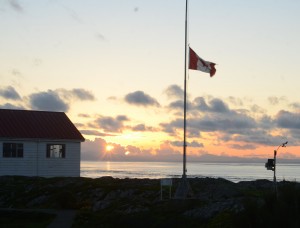The great weather with gentle outflow conditions continued for today but looks like we will be back to westerlies tomorrow and that may bring back the fog. The barometer slowly slid all day but is still relatively high.
There were only three tour boats today with the Bigg’s Killer Whales gone from this area and the Southern Resident Killer Whales in the Gulf Islands.
Several boaters were reported fishing illegally in the Race Rocks Close Conservation Area today. Juan de Fuca Warrior approached one of those boats and they pulled up and left the reserve. The people in the Juan de Fuca Warrior dropped off SCUBA divers just off of Great Race. I had to go on the VHF radio for the other two, both rentals from Pedder Bay Marina, other folks on the radio were supportive and eventually the poachers left.
Later when there were no fishers in the reserve, a Fisheries boat passed to the south and the Becher Bay Fisheries Patrol came through the reserve. Good to know that there are allies out there.
I completed the first part of the Glaucous-winged Gull mortality study today and didn’t have much time for any other substantial observations. Chris Blondeau came out with family visitors and delivered propane, food and other supplies. One thing we saw together was a California Sea Lion with and orange flipper tag on the left, front flipper and a ring around its neck or at least a mark from a line of some sort. It may have been healed but there was still an obvious mark. The orange tag means the individual had been at a rehabilitation centre in California, maybe the neck line was removed. Right now in California, many sea lions are having seizures and dying and some are being rehabilitated at Marine Mammal Centers, they are tagged on release too.. The illness is due to domoic acid poisoning from algal blooms.
Good news from off the rock but in the ‘hood’ today, as reported by the Center for Whale Research, L86 was seen with the first new calf in the Southern Resident Killer Whale population since 2012. That is really good news. right here is where they used to be captured for aquarium shows back in the day. Great to see that endangered population growing again.
Chores completed included simple things like fixing the hoses so they could be used without losing water like paper bags, adding peat moss to the compost and wetting it down so it won’t blow away immediately. The solar panels got an extra special fresh water cleaning today and I worked a bit on the jetty fence and science house perimeter.




